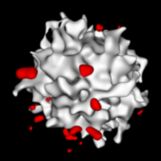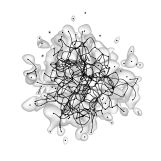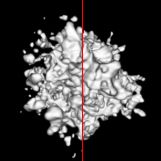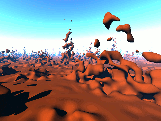Topological Correction
of Hypertextured Implicit Surfaces
for Ray Casting
Manuel N. Gamito
Steve C. Maddock
The University of Sheffield
Hypertextures are a useful modelling tool in that they can add
three-dimensional detail to the surface of otherwise smooth objects.
Hypertextures can be rendered as implicit surfaces, resulting in objects
with a complex but well defined boundary. However, representing a
hypertexture as an implicit surface often results in many small parts
being detached from the main surface, turning an object into a
disconnected set. Depending on the context, this can detract from the
realism in a scene where one usually does not expect a solid object to
have clouds of smaller objects floating around it. We present a topology
correction technique, integrated in a ray casting algorithm for
hypertextured implicit surfaces, that detects and removes all the
surface components that have become disconnected from the main surface.
Our method works with implicit surfaces that are C2 continuous and uses
Morse theory to find the critical points of the surface. The method
follows the separatrix lines joining the critical points to isolate
disconnected components.
This paper was presented at the Shape Modelling International 2007
conference, that was held in Lyon, France, from the 13th to the 15th of
June, 2007. The final paper is available from the IEEE Digital Library. A draft version of the paper is available below:
PDF format (442 K) (smi07.pdf)
The paper was later selected for publication in a special edition of The Visual Computer,
containing the best papers from the SMI '07 conference. The new paper
has been extended to include results for localised topology correction.
It also includes the expressions for the gradient vector and Hessian
matrix of the procedural noise functions used. The final paper is
available at www.springerlink.com. A draft version of the paper is available below:
PDF format (568 K) (topcorrvisual.pdf)
A localised form of topology correction was later developed to handle
very large implicit surfaces. The original model requires that all the
critical points of the surface be located as a first step. This becomes
impractical when the implicit surface represents a terrain with a
potentially infinite number of critical points. The localised version of
topology correction works by finding critical points only on a small
neighbourhood around each ray-surface intersection point. The
neighbourhood is grown, if necessary, until a definite answer about the
connectivity state of the intersection point can be given. Caching is
also used so that connectivity results can be reused for nearby
intersection points. A paper on the localised topology correction method
was presented at the EGUK's Theory and Practice of Computer Graphics 2008,
held in Manchester from the 9th to the 11th of June, 2008. The paper
won the prize for Best Student Paper for Technical Content. The paper is
available below:
PDF format (3152 K) (eguk2008.pdf)
Some Animations from the Papers
Here are four example animations illustrating several aspects of the
removal of disconnected surface components from a hypertextured sphere.
The animations can be visualised as an infinite cycle by turning on
looping in the movie viewer.
 |
A rotating spherical hypertexture,
showing the disconnected components marked in red. It is these red
components that have to be removed as part of the topological correction
method in order to have a hypertextured surface that is simply
connected.
Quicktime MOV format (6.7M) (morse1.mov) |
 |
The separatrix curves are shown in
wireframe inside a hypertextured sphere. This network of separatrix
curves is obtained with Morse Theory and encodes all the connectivity
information about the surface.
Quicktime MOV format (11.8M) (morse2.mov) |
 |
A rotating hypertextured sphere with
no topological correction (on the left) and after topological correction
(on the right). All the disconnected components of the surface
disappear on the right half of the animation.
Quicktime MOV format (11.9M) (morse3.mov) |
 |
An animated GIF showing the three
stages in the topological correction of a hypertextured terrain. The
first frame shows the original terrain with disconnected components. The
second frame corresponds to connectivity querying and shows the
disconnected components highlighted in green. The third and final frame
corresponds to full topology correction and shows the terrain without
disconnected components. Notice that shadows on the left part of the
image, cast by disconnected components not directly visible, also
disappear after topology correction. Click on the image for a larger
version. |



